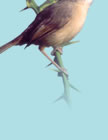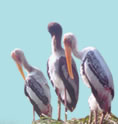
|

|
Recent Clippings
The Indian sub-continent is host in winter to a multitude of birds which have nested
further north in Asia, and migrate over the mountains to seek congenial winter quarters.
Some species, such as Rosy Starlings, migrate in large flocks over quite narrow
routes, but most migration is less obvious, and often takes place at night. Summer
visitors are inland migrators, like Pittas and Golden Orioles.
This story about longest-known nonstop journey by a sea bird
appeared in Times of India.
A Christmas Island frigate bird named Lydia recently made a non-stop journey of
just over 26 days and covering nearly 2,500 miles—across Indonesian volcanoes and
some of Asia's busiest shipping lanes —in search of food for her baby.
The trip, tracked by scientists at Christmas Island National Park, is by far the
longest-known nonstop journey by one of these critically endangered seabirds.
"It's a real revelation," said David James, coordinator of biodiversity monitoring
for Christmas Island National Park, the birds' only known breeding ground.
"The thing that really surprised me is that it was a long, nonstop journey, and
that she crossed overland over volcanoes," James said. "Normally, you would expect
the seabirds to fly over the sea."
Lydia's trip started October 18 from Christmas Island, an Australian territory in
the Indian Ocean about 310 miles south of Jakarta, and 1,600 miles northwest of
Perth.
Leaving a baby chick in the care of her partner, Lydia headed south over open waters
— probably to steal fish from other seabirds, a common habit among frigate birds.
She then circled back on October 26 and flew between Indonesia's Java and Sumatra
islands. From there, she headed across Borneo island on November 9 before flying
back over Java and returning on November 14. (AP)
Heard in our Yahoo group
The phenomenon of migratory birds
The migratory birds that alight on Sandspit backwaters every winter in Karachi represent
at least 20 countries.
These birds enter Pakistani airspace flying mostly at altitudes between five to
eight thousand feet when their feeding grounds in the North are covered with snow.
Some birds, though, may fly as high as 20,000 feet or more in their journey.
They fly over the Karakoram, the Hindukush, the Himalayas and the Pamirs. In Pakistan
they fly in the airspace above the Indus River, the Kurrum River and a host of other
valleys, and then fan out to alight on more than 100 lakes in the Indus delta, and
several ponds.
The demoiselle crane (koonj) flies so low that people in the Kurram Valley hunt
it with strings to one end of which is tied a stone. They swing the stone and then
throw it into air as high as it will go in the path of the flying demoiselle crane.
After many attempts they’re able to trap cranes which come to the ground making
a frantic effort to make their feet free from the thread.
The journey of these birds begin from one or more than one points in Russia,China,
Magnolia, Kazakhastan, Tibet, Iran, Afghanistan, and Sweden. A few species begin
their journey from the shores of the Caspian and the Black seas. At least in theory
some of these birds might have covered more than 9,000kms to reach Pakistan. But
most of the birds would cover half the distance or even less.
The journey of the coot, the most numerous of the migratory birds in the wetlands
of Punjab and Sindh, originates from Central Asia. Birds whose feathers are dishevelled
and rough indicate that they have had a tough flight. Because of the highest number
of lakes and wetlands in Sindh, a vast majority of the migratory birds spend their
entire winter in Sindh.
Over the years a perceptible change in the behaviour of migratory birds towards
human beings is much in evidence. Surkhab, the duck with a ruddy shell, in the last
century was so wary of human beings that it would hide itself in its cover at the
slightest noise or disturbance. It was because of this elusiveness that in Urdu
anything extremely difficult to attain or spot is alluded to as Surkhab Ke Par (the
feather of a surkhab).
Unlike its ancestors, the duck with a ruddy shell that visits Pakistan is not afraid
of human beings just as European or the common terns.
So, why has this change occurred in the behaviour of migratory birds? The reason
is obvious. The human population has grown manifold in the last few centuries. The
birds know that they will find human beings no matter where they go. Unlike their
ancestors they have become more used to the presence of human beings in their environment.
|

|
|

|
|
|

